Articles
- Page Path
- HOME > Korean J Community Nutr > Volume 17(6); 2012 > Article
-
Original Article
- Development and Effects' Analysis of Nutrition Education Pamphlet for the Higherr Grades Elementary Students: Focused on Individual Daily Needed Food Exchange Units
- Eun-Su Lim, Young-Sook Cho, Se-Na Kim, Sook-Bae Kim
-
Korean Journal of Community Nutrition 2012;17(6):689-706.
DOI: https://doi.org/10.5720/kjcn.2012.17.6.689
Published online: December 31, 2012
Graduate School of Education, Chonbuk National University, Jeonju, Korea.
1Department of Agrofood Resources, NAAS, RDA, Suwon, Korea.
2Department of Food Science & Human Nutrition, Research Institute of Human Ecology, Chonbuk National University, Jeonju, Korea.
- Corresponding author: Sook-Bae Kim, Chonbuk National University, 664-14, Duk-Jin Dong 1-Ga, Duk-Jin Gu, Jeonju 561-756, Korea. Tel: (063) 270-3823, Fax: (063) 270-3854, sbkim@jbnu.ac.kr
Copyright © 2012 The Korean Society of Community Nutrition
- 894 Views
- 0 Download
- 5 Crossref
Figure & Data
REFERENCES
Citations

- Effects of Nutrition Education Using Dietary Guidebook in Higher Grade Elementary Students of Jeonbuk Area
Mi-Ran Park, Sook-Bae Kim
Korean Journal of Community Nutrition.2018; 23(1): 13. CrossRef - Effects of Nutrition Education Providing School Lunch by Personalized Daily Needed Food Exchange Units for Adolescent Athletes in Jeonbuk Province
Kang-Mo Ko, Sook-Bae Kim
Korean Journal of Community Nutrition.2016; 21(1): 25. CrossRef - The Development of a Nutrition Education Program for Low-income Family Children by applying the Social Cognitive Theory and Health Belief Model
Saes-byoul Lee, Yu-Ri Jeong, Hyo-Jin Ahn, Min-Ji Ahn, Su-A Ryu, Nam-E Kang, Se-Young Oh
Korean Journal of Community Nutrition.2015; 20(3): 165. CrossRef - Analysis of Media Use in the Nutrition Education on Knowledge, Attitude and Practice of the Breakfast Habits on Elementary School Students
Nurlaely Fitriana, Siti Madanijah, Ikeu Ekayanti
Pakistan Journal of Nutrition.2015; 14(6): 335. CrossRef - Effects of Nutrition Education for Chinese College Students in Korea - Focused on Personalized Daily Energy Requirement and Food Exchange Units -
Jia-Li Guo, Soon-Kyung Kim, Jeong-Weon Kim, Mi-Hyun Kim, Se-Na Kim, Sook-Bae Kim
Korean Journal of Community Nutrition.2013; 18(6): 565. CrossRef
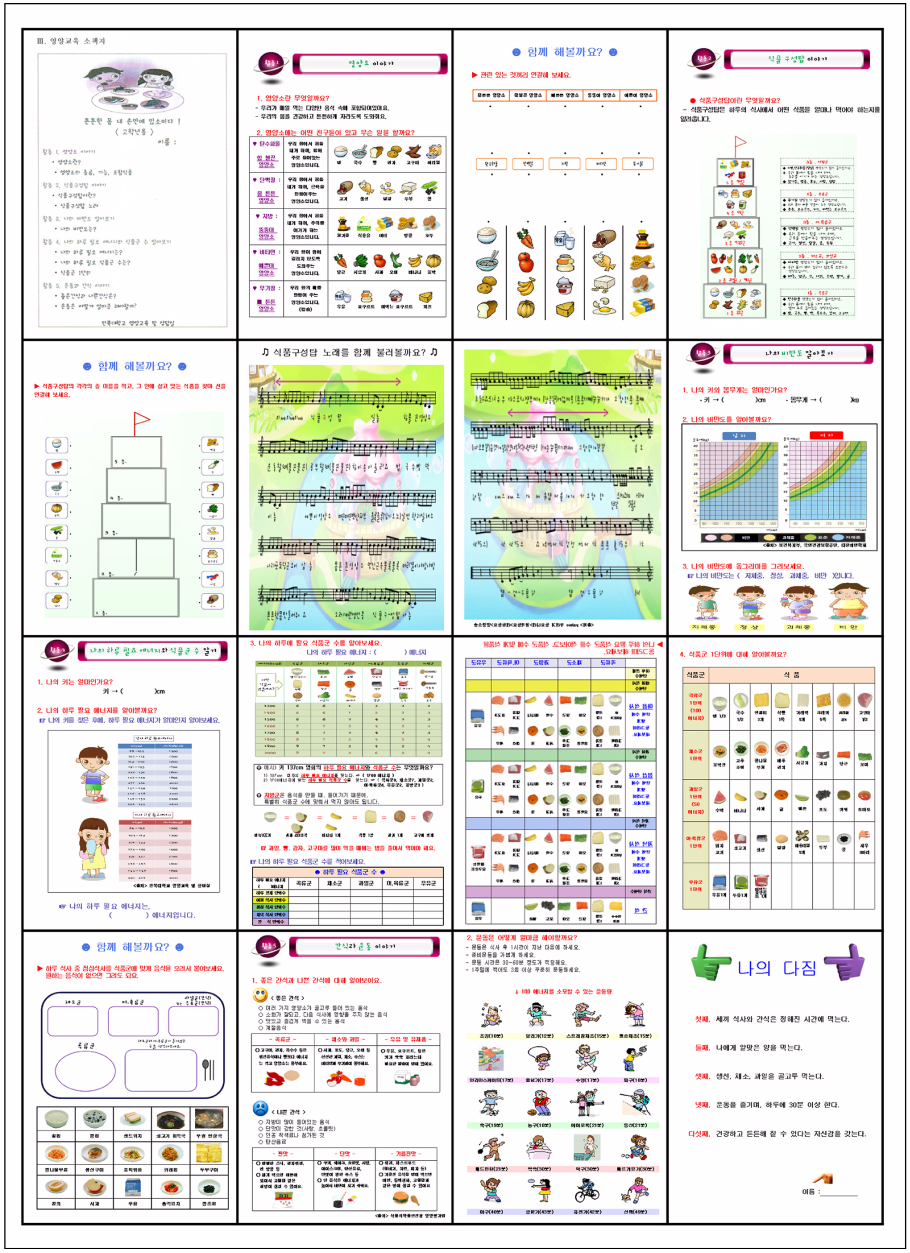
Fig. 1
The contents and tools of nutrition education
General characteristics of the subjects
1) N (%)
Height, weight, obesity index of subjects
1) Values are Mean ± SD
2) By ANCOVA test
Obesity index (%) =
< -10: underweight, -10 ≤ < 10: normal, 10 ≤ < 20: overweight, 20 ≤ obese
N (%)
*: p < 0.05 by t-test
NS: Not Significant
Dietary attitudes of the subjects
1) Values are Mean ± SD
2) By ANCOVA test
3) Denotes a negatively phrased and reversely scored item
**: p < 0.01, ***: p < 0.001 by t-test
NS: Not Significant
Food attitudes of the subjects
1) N (%)
*: p < 0.05, **: p < 0.01 by chi-square test
NS: Not Significant
Nutrition knowledge of the subjects
1) Values are Mean ± SD
2) By ANCOVA test
*: p < 0.05, **: p < 0.01 by t-test
NS: Not Significant
Nutrient intakes of subjects
1) Values are Mean ± SD
2) by ANCOVA test
*: p < 0.05, **: p < 0.01, ***: p < 0.001 by t-test
NS: Not Significant
Carbohydrate : Protein : Fat(CPF) ratio of subjects
1) Values are Mean ± SD
2) ***: p < 0.001 by ANCOVA test
**: p < 0.01, ***: p < 0.001 by t-test
CPF: Carbohydrate, Protein, Fat
NS: Not Significant
Macronutrient intakes of subjects
1) N (%)
2) EER: Estimated Energy Requirement
3) EAR: Estimated Average Requirement
4) RNI: Recommended Nutrient Intake
5) AI: Adequate Intake
*: p < 0.05 by Mann-Whitney U Test
NS: Not Significant
Vitamin intakes of subjects
1) EAR: Estimated Average Requirement
2) N (%)
3) RNI: Recommended Nutrient Intake
4) UL: Tolerable Upper Intake Level
5) AI: Adequate Intake
*: p < 0.05 by Mann-Whitney U Test
NS: Not Significant
Mineral intakes of subjects
1) EAR: Estimated Average Requirement
2) N (%)
3) RNI: Recommended Nutrient Intake
4) By ANCOVA test
5) UL: Tolerable Upper Intake Level
6) AI: Adequate Intake
7) Goal: Population nutrient intake goal
**: p < 0.01 by Mann-Whitney U Test
Satisfaction with nutrition education pamphlet of subjects
1) N (%)
2) Values are Mean ± SD
Score) Dissatisfied: 1, Normal: 2, Satisfied: 3
1) N (%)
1) Values are Mean ± SD 2) By ANCOVA test Obesity index (%) = < -10: underweight, -10 ≤ < 10: normal, 10 ≤ < 20: overweight, 20 ≤ obese N (%) *: NS: Not Significant
1) Values are Mean ± SD 2) By ANCOVA test 3) Denotes a negatively phrased and reversely scored item **: NS: Not Significant
1) N (%) *: NS: Not Significant
1) Values are Mean ± SD 2) By ANCOVA test *: NS: Not Significant
1) Values are Mean ± SD 2) by ANCOVA test *: NS: Not Significant
1) Values are Mean ± SD 2) ***: **: CPF: Carbohydrate, Protein, Fat NS: Not Significant
1) N (%) 2) EER: Estimated Energy Requirement 3) EAR: Estimated Average Requirement 4) RNI: Recommended Nutrient Intake 5) AI: Adequate Intake *: NS: Not Significant
1) EAR: Estimated Average Requirement 2) N (%) 3) RNI: Recommended Nutrient Intake 4) UL: Tolerable Upper Intake Level 5) AI: Adequate Intake *: NS: Not Significant
1) EAR: Estimated Average Requirement 2) N (%) 3) RNI: Recommended Nutrient Intake 4) By ANCOVA test 5) UL: Tolerable Upper Intake Level 6) AI: Adequate Intake 7) Goal: Population nutrient intake goal **:
1) N (%) 2) Values are Mean ± SD Score) Dissatisfied: 1, Normal: 2, Satisfied: 3

 KSCN
KSCN


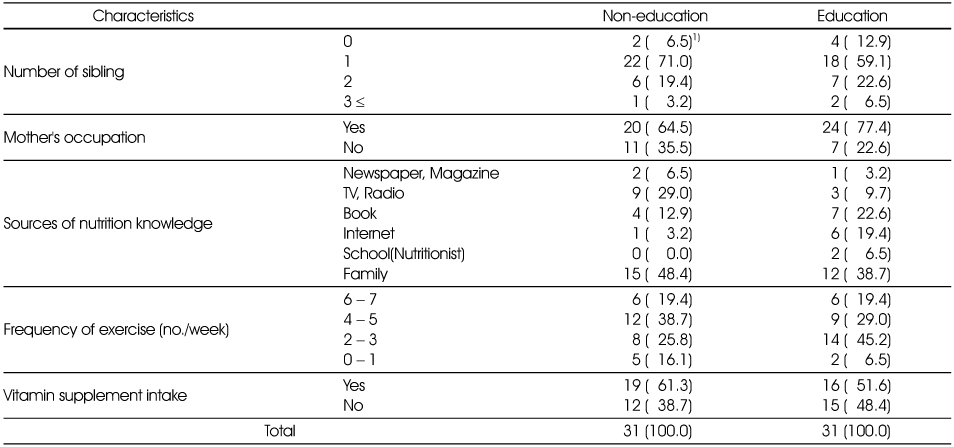



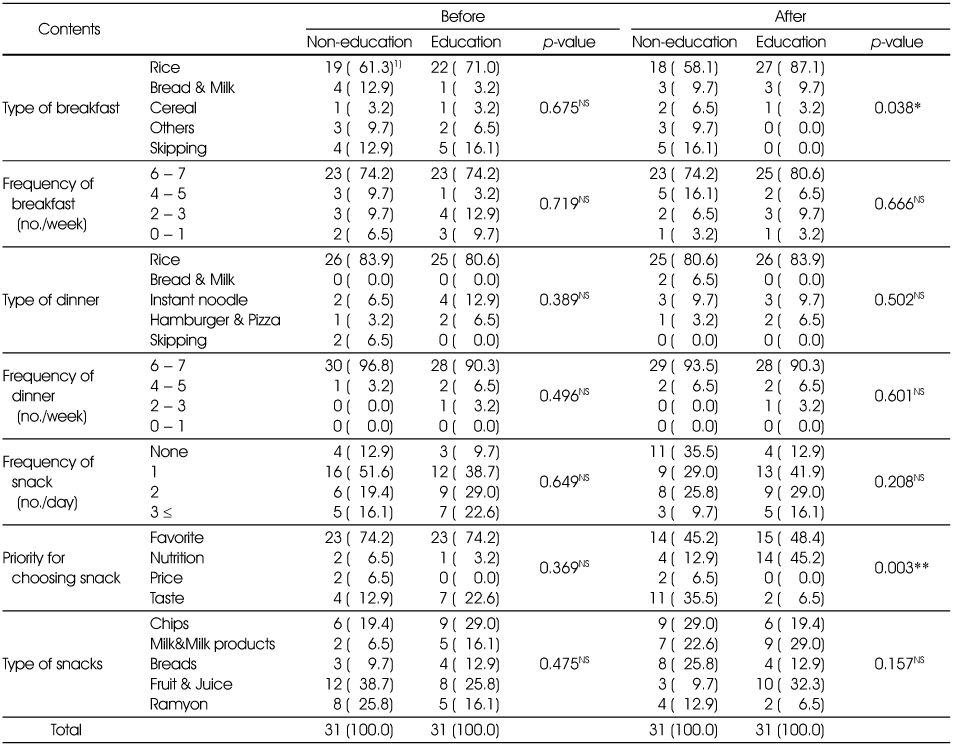
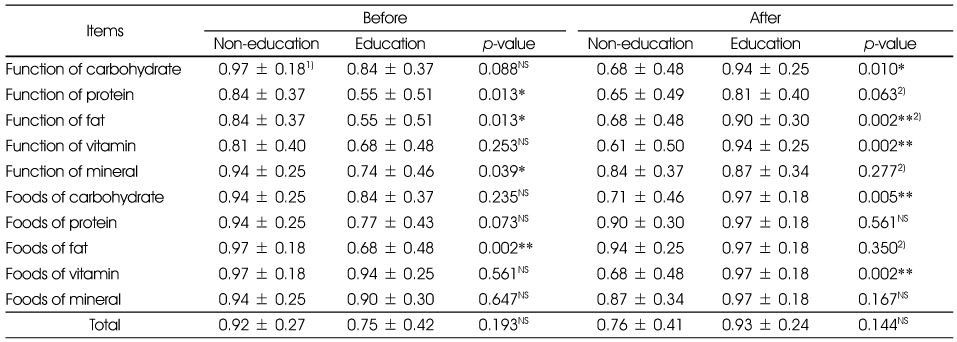
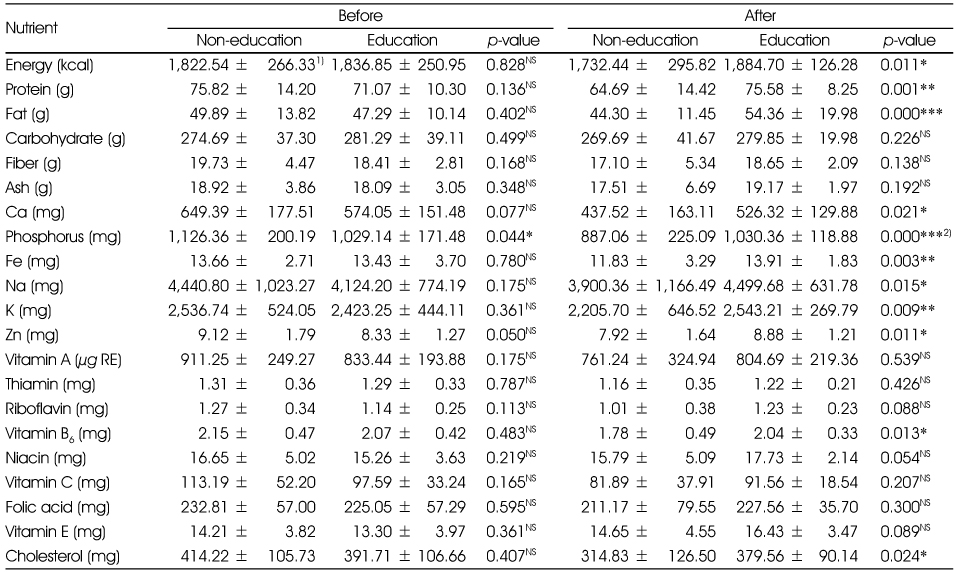


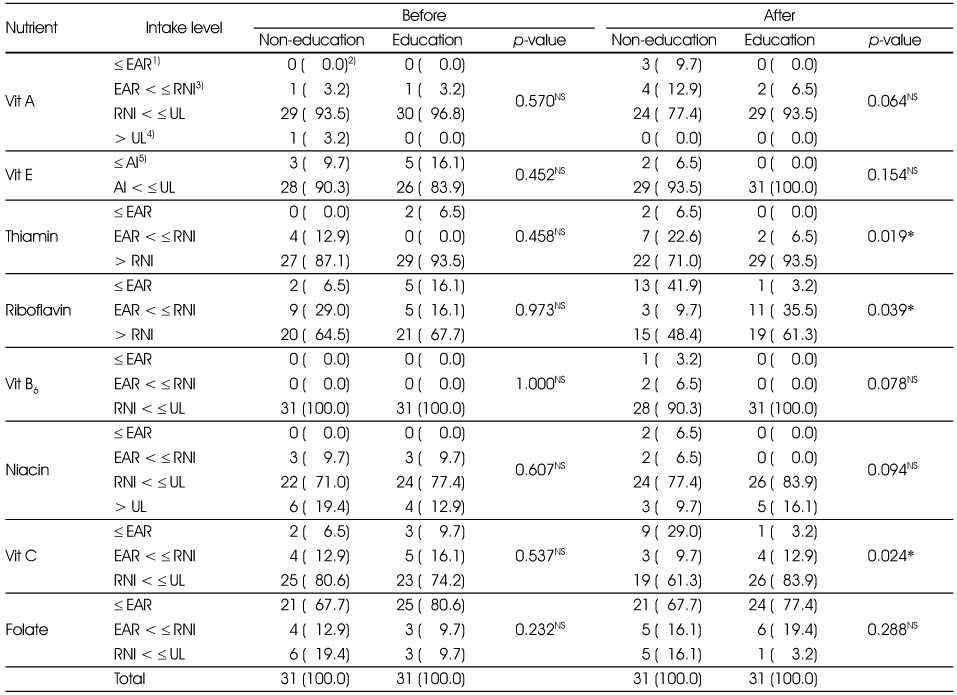
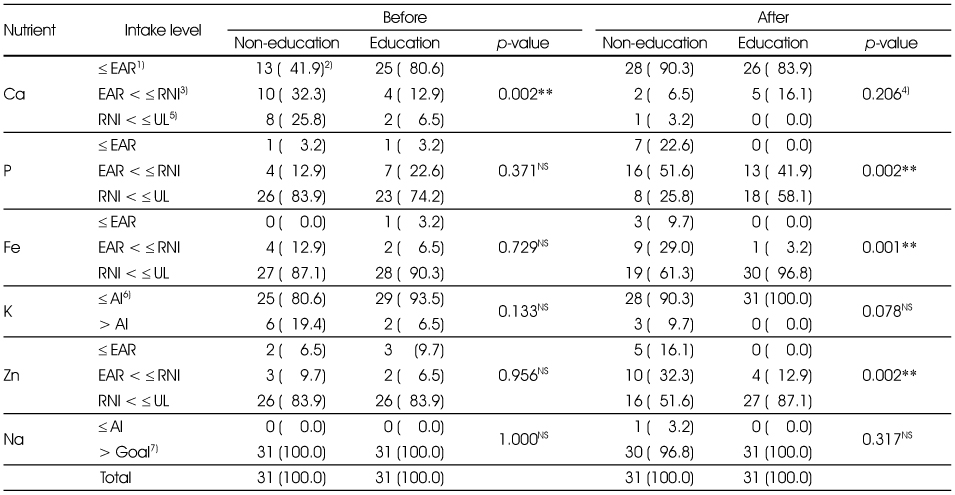
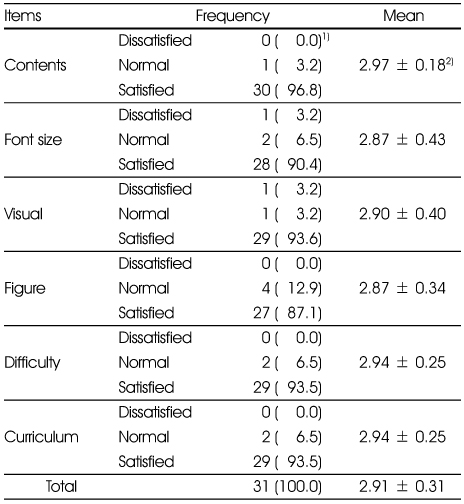
 PubReader
PubReader Cite
Cite


